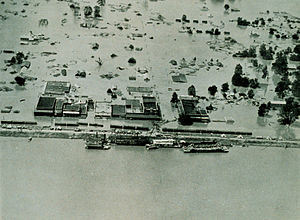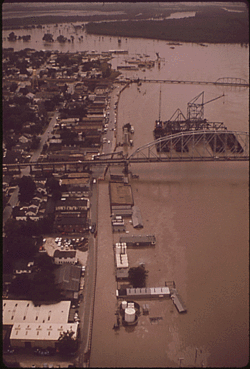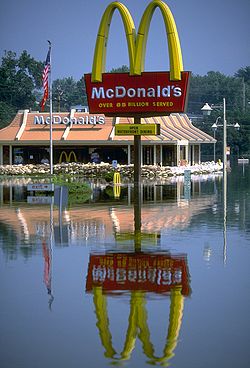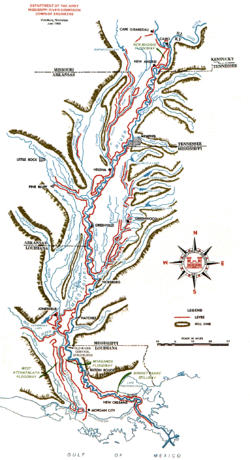- Mississippi River floods
-
The Mississippi River and its tributaries have flooded on numerous occasions.[1] This is a list of major floods.
Flood of March 1543
Hernando DeSoto's party was passing through a village at the confluence of the Mississippi River and Arkansas River on March 18. The ensuing flood only allowed passage by canoe and inundated fields surrounding the town. [2] The flooding reportedly lasted for 40 days.[3][4]
Flood of 1734-35
From December to June the City of New Orleans was inundated.[4][5]
Flood of 1788
In July, severe flooding of the Mississippi River resulted from a hurricane landfall.[5]
Flood of 1809
All of the lower Mississippi River was inundated by flooding.[5]
Flood of 1825
The flood of 1825 is the last known inundation of New Orleans due to spring flooding.[5]
Great Flood of 1844
Main article: Great Flood of 1844The largest flood ever recorded on the Missouri River and Upper Mississippi River in terms of discharge. This flood was particularly devastating since the region had little or no levees at the time. Among the hardest hit were the Wyandot who lost 100 people in the diseases that occurred after the flood. The flood also is the highest recorded for the Mississippi River at St. Louis. After the flood, Congress in 1849 passed the Swamp Act providing land grants to build stronger levees.[6]
Great Flood of 1851
Main article: Flood of 1851The flood occurred after record-setting rainfalls across the U.S. Midwest and Plains from May to August, 1851. The State of Iowa experienced significant flooding extending to the Lower Mississippi River basin. Historical evidence suggest flooding occurred in the eastern Plains, from Nebraska to the Red River basin, but these areas were sparsely settled in 1851. Heavy rainfall also occurred in the Ohio River basin. In June, major flooding on the Mississippi River was experienced.[4][5]
Great Mississippi Flood of 1927
Main article: Great Mississippi Flood of 1927 The Great Mississippi Flood of 1927, Arkansas City, Arkansas.
The Great Mississippi Flood of 1927, Arkansas City, Arkansas.
The 1927 flood was the greatest flood in modern history on the Lower MS River. In the summer of 1926 until the spring of 1927, heavy rains fell in eastern Kansas, Oklahoma, and the Ohio Valley. The White and Little Red rivers broke through the levees in Arkansas in February, flooding over 400 km2 (99,000 acres) with 3 to 5 m (9.8 to 16 ft) of water.[7] The first levee break along the Mississippi River occurred a few miles south of Elaine, Arkansas on March 29.[2] Over the next six weeks, numerous levees broke along the Mississippi River from Illinois to Louisiana, which inundated numerous towns in the Mississippi Valley. The break at Mounds Landing near Greenville, Mississippi was the single greatest crevasse to ever occur along the Mississippi River. It flooded an area 80 km (50 mi) wide and 160 km (99 mi) long with up to 6 metres (20 ft) of water. Heavy spring rains caused a second major flood in the same region that June. In all, 73,500 km2 (28,400 sq mi) which were home to more than 931,000 people were inundated. To avoid flooding the city of New Orleans, the governor of Louisiana allowed engineers to create the Poydras cut, which saved the city but led to the flooding of St. Bernard and Plaquemines parishes instead. Millions of acres across seven states were flooded. Evacuees totaled 500,000. Economic losses were estimated at US$1 billion (1927 dollars), which was equivalent to almost one-third of the federal budget at that time. [8]
Great Flood of 1937
Main article: Ohio River flood of 1937The Ohio River flood of 1937 took place in late January and February 1937. With damage stretching from Pittsburgh to Cairo, Illinois, one million persons were left homeless, with 385 dead and property losses reaching $500 million. The Bonnet Carre Spillway was opened for the first time and had 285 of the 350 bays opened for 48 days. New Orleans crested at 19.29 feet (5.88 m) on Feb 28th.[5]
Flood of 1945
Flooding between March and May resulted in Baton Rouge reaching its second highest recorded crest at 45.18 feet (13.77 m) on April 29. The Bonnet Carre Spillway was opened for the second time for 57 days.[5]
Mississippi Flood of 1973
Main article: Mississippi Flood of 1973 Aerial view of the flood waters in Morgan City, Louisiana May, 1973
Aerial view of the flood waters in Morgan City, Louisiana May, 1973
The Mississippi Flood of 1973 occurred between March and May 1973 on the lower Mississippi River.[5] The flood resulted in the largest volume of water to flow down the Mississippi since the Great Mississippi Flood of 1927. Both the Bonnet Carre Spillway and the Morganza Spillway were employed. The Bonnet Carre was fully opened between April 7 and June 14 for a record 75 days. The 1973 flood was the first time the Morganza Spillway was opened: from April 19 through June 13.
Flood of 1975
In April, 225 bays of the Bonnet Carre Spillway were opened for 15 days, the shortest duration on record. Reserve, Louisiana had a crest of 24 feet (7.3 m) on April 14. the 8th highest on record.[5]
Flood of 1979
April, all 350 bays of the Bonnet Carre Spillway were opened for 45 days. Red River Landing crested at 59.19 feet (18.04 m) on April 23.[5]
Lower Mississippi Flood of 1983
The flood between May and June was the second most severe flood in the lower Mississippi Basin since 1927. Red River Landing, Louisiana, reached the 4th highest crest of record at 60.52 feet (18.45 m) on June 5 and was flooded for 115 days. All bays of the Bonnet Carre Spillway were opened for 35 days.[5]
 Great Flood of 1993, with the Mississippi River out of its banks in Festus, Missouri.
Great Flood of 1993, with the Mississippi River out of its banks in Festus, Missouri.
Great Mississippi and Missouri Rivers Flood of 1993
Main article: Great Mississippi and Missouri Rivers Flood of 1993The flood occurred on the Mississippi and Missouri rivers and their tributaries between April to October 1993. The flooded area totaled around 30,000 square miles (80,000 km²)[9] and was the worst since the Great Mississippi Flood of 1927 as measured by duration, square miles inundated, persons displaced, crop and property damage, and number of record river levels.
Flood of 2002
In April, Red River Landing reached 58.60 ft (17.86 m), the 8th highest crest on record.[5]
Flood of 2008
Main article: Iowa flood of 2008Between April 11 and May 12, heavy rain in the Mississippi River Valley necessitated the opening of the Bonnet Carre Spillway for the first time in 11 years. 160 bays were opened for 31 days. Red River Landing crested at 60.68 feet (18.50 m) on April 24, the 3rd highest on record .[5]
Great Mississippi Flood of 2011
Main article: 2011 Mississippi River floods Old train depot along the Mississippi River in Vicksburg, Mississippi., May 13, 2011.
Old train depot along the Mississippi River in Vicksburg, Mississippi., May 13, 2011.
The Mississippi River floods in April and May 2011 were among the largest and most damaging along the U.S. waterway in the past century, rivaling major floods in 1927 and 1993. In April 2011, two major storm systems dumped record rainfall on the Mississippi River watershed. Rising from springtime snowmelt, the river and many of its tributaries began to swell to record levels by the beginning of May. Areas along the Mississippi itself experiencing flooding include Illinois, Iowa, Missouri, Kentucky, Tennessee, Arkansas, Mississippi, and Louisiana. U.S. President Barack Obama declared the western counties of Kentucky, Tennessee, and Mississippi federal disaster areas.[10] For the first time in 38 years, the Morganza Spillway has been opened, deliberately flooding 4,600 square miles (12,000 km2) of rural Louisiana to save most of Baton Rouge and New Orleans.[11]
See also
References
- ^ "FLOODS ON THE LOWER MISSISSIPPI: AN HISTORICAL ECONOMIC OVERVIEW". SR/SSD 98-9. NOAA. March 1. http://www.srh.noaa.gov/topics/attach/html/ssd98-9.htm. Retrieved 2011-05-24
- ^ a b Brad Edmondson. 1927 Mississippi River flood. Retrieved on 2006-11-30.
- ^ World Meteorological Organization. The Associated Programme on flood Management. Retrieved on 2006-11-30.
- ^ a b c Hoyt, William G. and W.B. Langbein. "Floods". New Jersey: Princeton University Press, 1955. p. 422.
- ^ a b c d e f g h i j k l m "High Flows and Flood History on the Lower Mississippi River". National Weather Service. 2010-03-12. http://www.srh.noaa.gov/lix/?n=ms_flood_history. Retrieved 2011-05-20.
- ^ Jackson County 175th Anniversary Timeline
- ^ 75th Anniversary of the Great Flood of 1927
- ^ "Mississippi Floods – Archive Collection – TIME". Time. http://www.time.com/time/archive/collections/0,21428,c_mississippi_floods,00.shtml.
- ^ (English)"High Water: Building A Global Flood Atlas". NASA Earth Observatory. http://earthobservatory.nasa.gov/Study/HighWater/. Retrieved 2007-10-25.
- ^ "Obama Signs Tennessee Disaster Declaration". Blog.memphisdailynews.com. 2011-05-09. http://blog.memphisdailynews.com/?p=2209. Retrieved 2011-05-16.
- ^ "Rural Louisiana flooded to save New Orleans" (CBS News/Associated Press) May 14, 2011
Categories:
Wikimedia Foundation. 2010.

